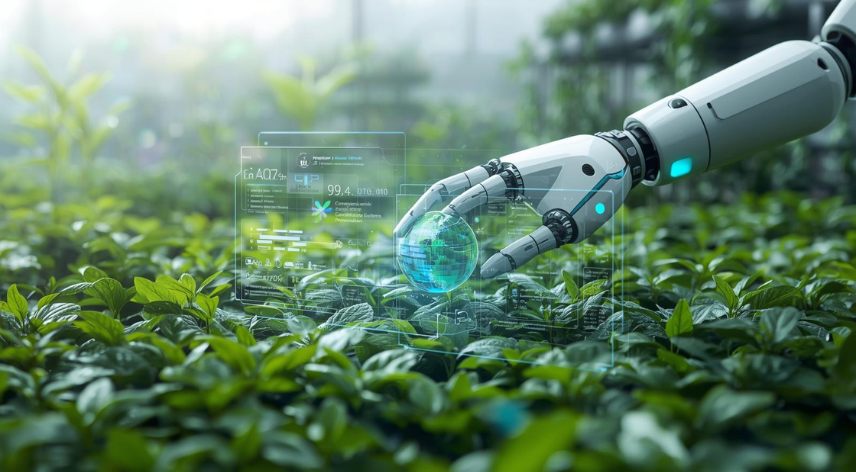Artificial Intelligence (AI) is emerging as a transformative force in driving sustainability and environmental innovation. From optimizing energy consumption to revolutionizing waste management and advancing renewable energy systems, AI is helping industries transition toward greener, more efficient operations. This blog explores how AI integrates with sustainable technologies, the core mechanisms behind it, real-world applications, benefits, challenges, and the future of AI-powered environmental transformation.
Introduction
In the face of accelerating climate change, resource scarcity, and rising energy demands, global industries are turning toward AI to build a sustainable future. AI’s capability to process massive data sets, identify patterns, and predict outcomes makes it indispensable in addressing environmental challenges efficiently and intelligently.
From managing smart grids and improving recycling systems to advancing climate modeling and precision agriculture, AI’s role in sustainable technologies has become a cornerstone for environmental innovation. As nations and corporations push toward net-zero goals, AI stands as the backbone of this green revolution enabling data-driven sustainability, reducing waste, and optimizing renewable energy sources.
What is It
AI in Sustainable and Green Technologies refers to the use of artificial intelligence, machine learning, and data analytics to create eco-friendly solutions that minimize environmental impact. These technologies work by gathering and analyzing data from various sources such as sensors, smart grids, and satellites to make informed decisions that improve resource efficiency and reduce carbon emissions.
Examples include:
-
Smart Energy Management Systems – AI optimizes electricity distribution and usage.
-
AI in Agriculture – Enhances crop yield while reducing water and fertilizer waste.
-
AI-driven Recycling Systems – Automates waste sorting and material recovery.
-
Climate Forecasting Tools – Predict and mitigate natural disasters with precision.
-
Sustainable Manufacturing – Reduces energy use and operational waste through predictive maintenance.
Each of these applications showcases how AI can support the global shift toward a cleaner, smarter, and more sustainable planet.
Core Technology
AI-powered sustainability relies on several key technological foundations that enable intelligent environmental management:
-
Machine Learning (ML): Analyzes complex environmental data to make real-time predictions and optimizations.
-
Internet of Things (IoT): Connects devices and sensors across cities, factories, and farms for smart monitoring.
-
Big Data Analytics: Processes large datasets to uncover trends in energy use, pollution, and resource consumption.
-
Computer Vision: Used in waste sorting, forest monitoring, and wildlife protection through image recognition.
-
Predictive Analytics: Anticipates maintenance needs in renewable systems, preventing energy loss.
-
Cloud and Edge Computing: Enables decentralized and scalable AI-powered sustainability solutions.
By integrating these technologies, AI systems deliver actionable insights, automate environmental decision-making, and enhance global efficiency in sustainability projects.
Uses of Technology
AI-driven sustainability applications span across multiple industries and environmental initiatives:
-
Renewable Energy Optimization: AI forecasts solar and wind energy output for grid stability.
-
Smart Cities: Reduces traffic emissions and energy consumption with intelligent infrastructure.
-
Precision Agriculture: Optimizes irrigation, pest control, and soil health management.
-
Climate Change Modeling: Improves accuracy in weather prediction and disaster response.
-
Waste Management: Uses robotics and computer vision for efficient recycling processes.
-
Water Conservation: AI systems monitor leaks and optimize water distribution networks.
-
Sustainable Manufacturing: Predicts energy demands and minimizes production waste.
These applications demonstrate how AI transforms sustainability from a concept into a scalable, data-driven global movement.
Benefits
AI’s integration with sustainable technologies yields profound environmental, economic, and social benefits:
-
Reduced Carbon Footprint: AI optimizes energy use across industries, reducing emissions.
-
Efficient Resource Management: Enhances water, energy, and raw material utilization.
-
Cost Savings: Predictive systems lower operational and maintenance expenses.
-
Improved Decision-Making: Real-time analytics guide smarter environmental strategies.
-
Sustainable Innovation: Encourages the development of eco-friendly products and services.
-
Enhanced Climate Resilience: Strengthens disaster preparedness through predictive modeling.
-
Global Environmental Impact: Accelerates the transition to carbon neutrality and net-zero targets.
Together, these advantages position AI as an essential enabler of the global green transition.
Implementation & Challenges
While AI-driven sustainability offers immense promise, its implementation presents several challenges:
Implementation Steps:
-
Data Collection: Gathering accurate environmental and operational data.
-
Model Training: Developing machine learning models tailored to specific sustainability goals.
-
Integration: Embedding AI into existing energy, industrial, or municipal systems.
-
Continuous Monitoring: Using real-time analytics for adaptive optimization.
Challenges:
-
Data Quality and Accessibility: Reliable datasets are crucial but often limited.
-
High Implementation Costs: Developing AI infrastructure can be capital-intensive.
-
Energy Demand of AI Models: Training large AI systems consumes significant power.
-
Ethical and Privacy Concerns: Data collection must respect user privacy and fairness.
-
Regulatory Barriers: Lack of global standards for sustainable AI applications.
To overcome these issues, organizations must prioritize green AI models, renewable-powered data centers, and collaborative sustainability frameworks.
Conclusion
AI has become a catalyst for a cleaner, more sustainable world. By integrating advanced technologies into energy, agriculture, manufacturing, and urban planning, AI enables smarter decisions that balance economic growth with ecological preservation.
As innovation continues, the focus must remain on building ethical, energy-efficient, and transparent AI systems that empower global sustainability. The future of AI in green technologies is not just about technological advancement, it's about creating a smarter planet where innovation and environmental responsibility coexist harmoniously.
